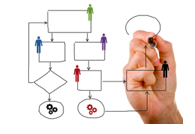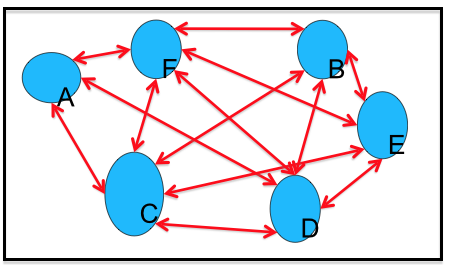How do we manage an organization to cope with complexity? It means understanding the organization as a system and seeing the interdependencies.
Independence vs. interdependence
What can the theory of systems tell us about managing organizations? First of all, if all the components that make up the system are independent, then the maximum result that the system can produce is simply the sum of the efforts of each component. A good example of that would be a bowling team.
 On the other hand, if the components of the system are interdependent, then the maximum result that the system can produce is all about the interactions among the parts ( see the red lines in the image below).
On the other hand, if the components of the system are interdependent, then the maximum result that the system can produce is all about the interactions among the parts ( see the red lines in the image below).
In this situation, it would be completely inappropriate to think that the sum of the parts is the whole. Instead, the way the components interdepend and interact is what determines the end result. A good example of this would be a football team, and the success of the Patriots is largely based on their understanding of this phenomenon.
Managing an organization through interdependencies
What does this mean when it comes to managing organizations? It changes everything. This is because the interactions among the components are not linear. Something new emerges form these interactions, and this is the reality we have to manage. How do we do that?
A systemic approach to the economics and management of resources in an organization looks at interdependencies. It focuses on what can be achieved by combining the resources at hand. This requires synchronization.
The goal of synchronization is to make the most out of what we have as a system. The cognitive ordeal that we face in embracing such a model is that the resources do not “belong” to something; they cannot be allocated in any conventional “functional” way. Achieving a systemic optimum is a very different sport from achieving a set of functional optima. Everything has to be subordinated to the constraint of the system. In fact, in the systemic game, resources are generally sub-optimized locally in order to optimize the global systemic result.
The Playbook
This may sound strange and new to some people, but it’s actually a much more natural way of organizing resources than forcing them into artificial silos and functions. How do we operationally reinforce synchronization within our system? When we build our organization as a systemic structure, one of the vital components to keep the structure alive and working is what we can call the Playbook. This is a detailed map of all our processes and the repository of all the knowledge needed to operate the interdependencies.
A playbook is built by mapping out in detail all the interactions that lead to the goal of the system. This can be achieved with Deployment Flow Charts and this mapping process alone can lead to significant improvements in the way processes are carried out.
When you manage the interdependencies in your organization you create the possibility for something much mightier than a bowling team. You free up the possibility for the organization to improve its performance as a whole.
Sign up to our blog here and shift your thinking towards broader, systemic possibilities for yourself and your organization. Intelligent Management provides education and training on systemic management, W. Edwards Deming’s management philosophy and the Theory of Constraints (Decalogue methodology) in North America and Europe.
About the Author
Angela Montgomery Ph.D. is Partner and Co-founder of Intelligent Management and author of the business novel+ website The Human Constraint , so far purchased in 21 countries around the globe. This downloadable novel uses narrative to look at how the Deming approach and the Theory of Constraints can create the organization of the future, based on collaboration, network and social innovation. She is co-author with Dr. Domenico Lepore, founder, and Dr. Giovanni Siepe of ‘Quality, Involvement, Flow: The Systemic Organization’ from CRC Press, New York.








Hi Angela
Very good article showing the principles of system dynamics specially in the usual case of interdependencies. Synchronization is the moto a normal person can understand that but how to find the constraint in order to achieve this Sync. ? How do you find the Constraint in a team of people ?
Best
Luis
Hi Luis,
Thanks for this comment. Our approach is based on a paradigm of synchronization and transparency. Any team has to be working on a specific project because they have the relevant competencies and that project has been carefully mapped and the tasks scheduled using the Critical Chain algorithm. The Critical Chain is the constraint of the project. It should be quite clear, then, who is supposed to do what and when. If people get ‘stuck’ then it means they are in some sort of conflict and this can be quite quickly resolved using the Conflict Cloud. If, instead, your question is about whether people are pulling their weight or not, that should not be an issue if it is clear, as I mentioned, that everybody knows who should be doing what and when. Regarding people pulling their weight, there is a very nice video on LinkedIn https://www.linkedin.com/feed/update/urn:li:activity:6298381252403793920